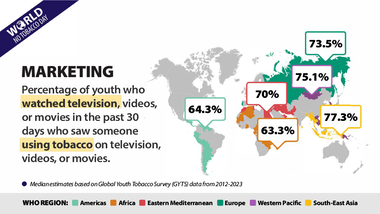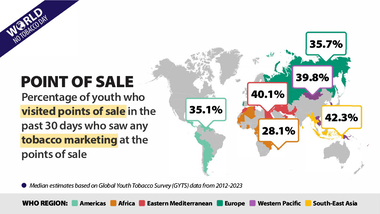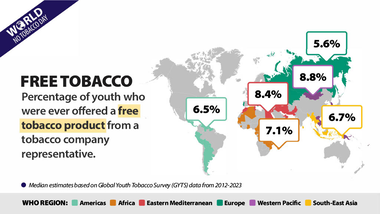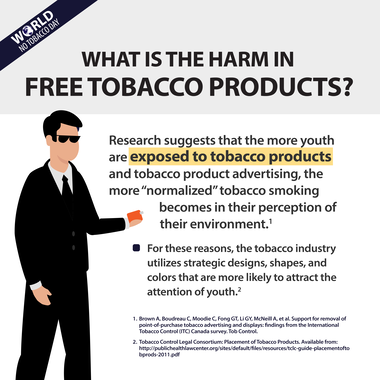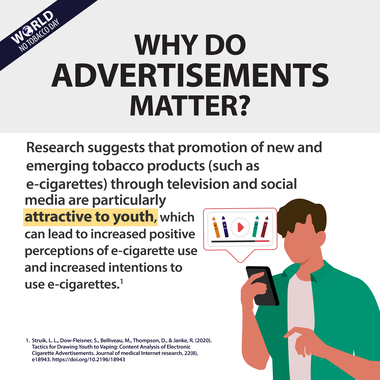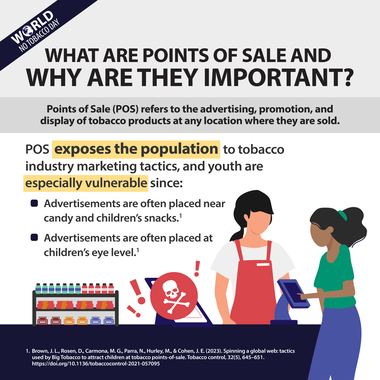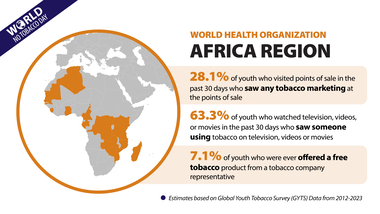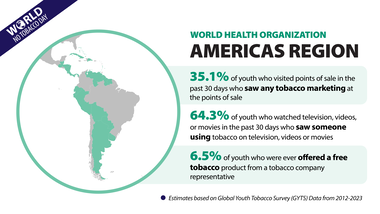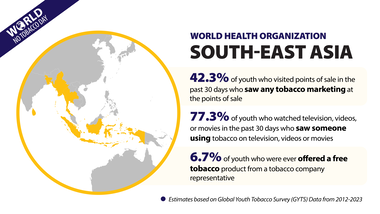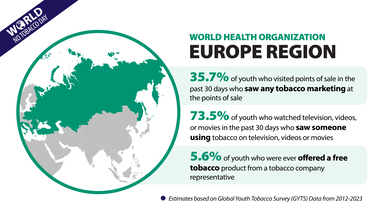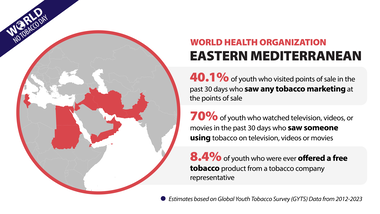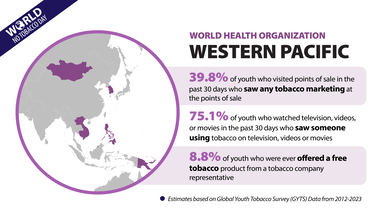Infographic

World No Tobacco Day 2025
PROTECTING YOUTH FROM TOBACCO INDUSTRY INFLUENCE
NO AMOUNT OF YOUTH TOBACCO USE IS SAFE. Globally, 50 million youth aged 13-15 years smoke cigarettes or use smokeless tobacco products. Evidence shows that tobacco company advertising and promotion influence youth to start using tobacco.
The Global Tobacco Surveillance System (GTSS) monitors how people use tobacco and important factors for controlling tobacco use. This surveillance system collects data through four different surveys including one focused on youth.
2012-2023 Global Youth Survey Results The maps below show global estimates of advertisement practices based on data collected from the Global Youth Tobacco Survey between 2012-2023. This is a nationally representative survey to understand tobacco use among school-based students aged 13-15 years.
POINT OF SALE
Median percentage of 13–15-year-olds who visited points of sale in the past 30 days who saw any tobacco marketing at the points of sale*
MARKETING
Median percentage of 13–15-year-olds who watched television, videos, or movies in the past 30 days who saw someone using tobacco*
FREE TOBACCO
Median percentage of 13-15-year-olds who were ever offered a free tobacco product from a tobacco company representative*
PROTECTING YOUTH
The GTSS Academy website hosts data from over 200 countries, freely available. Countries around the world can leverage this data into action to inform their efforts and further empower work to protect youth from the harms of tobacco.
GTSS Academy is supported by the CDC Foundation with grants from Bloomberg Philanthropies’ Bloomberg Initiative to Reduce Tobacco and the Bill & Melinda Gates Foundation.
1. Vital Strategies. (2023, October 26). Youth. The Tobacco Atlas. https://tobaccoatlas.org/challenges/youth/
2. 2Wang TW, Gentzke AS, Ne LJ, et al. Characteristics of e-Cigarette Use Behaviors Among US Youth, 2020. JAMA Netw Open. 2021;4(6):e2111336. doi:10.1001/jamanetworkopen.2021.11336
*Data presented here represent median estimates calculated using available Global Youth Tobacco Survey data from 2012-2023.
CONTACT INFORMATION: [email protected]
Blog: Vaping, Mental Health, and the Tobacco Industry: Why Youth Deserve Our Protection
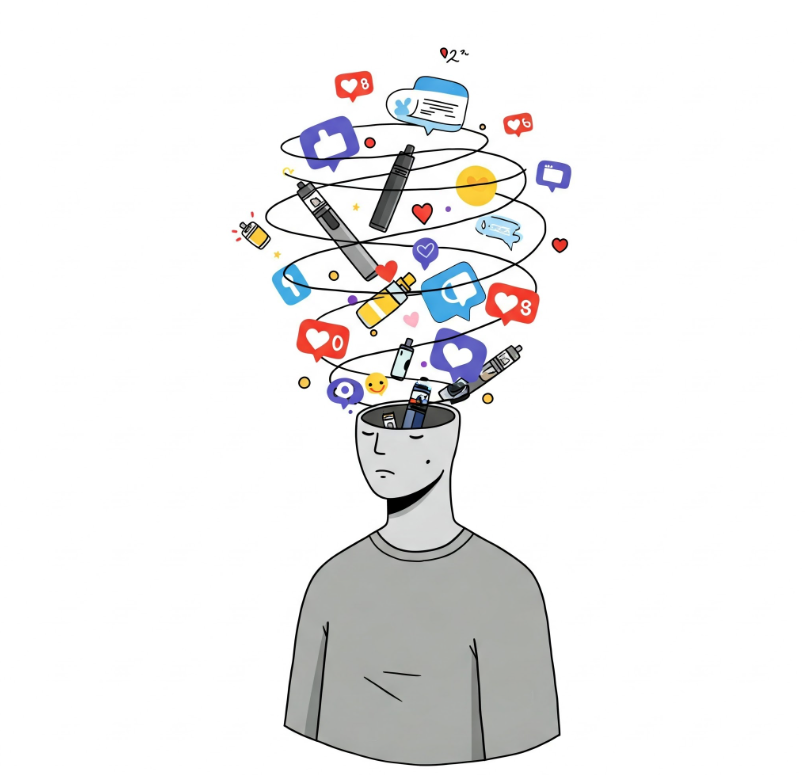
By Amaya Carthan BS, MPH & Adriana Dragicevic MS, CHES
Each year, World No Tobacco Day reminds us that protecting future generations from tobacco harms is not only a public health priority—it's a moral imperative. In 2025, the campaign's theme, Protecting children from tobacco industry interference", rings especially urgent. One area of growing concern? The powerful link between youth vaping and mental health.
The E-Cigarette Crisis Among Youth
In the United States, e-cigarettes have been the most commonly used tobacco product among adolescents since 2014. Although recent data show declines in usage—from 11.3% in 2022 to 5.9% in 2024 among middle and high school students—over 1.6 million youths still reported current e-cigarette use in 2024. Nearly 9 in 10 used flavored products, and 1 in 4 reported using them daily.
These patterns matter. The appeal of flavored e-cigarettes and their ease of concealment have made them deeply embedded in youth culture. Despite partial flavor bans, flavored disposable e-cigarettes remain widely available—and widely used.
Marketing That Targets Minds—and Mental Health
The tobacco marketing of today continues to evolve to appeal to youth. Today’s e-cigarette companies rely on digital ecosystems, social media influencers, and pop culture events to embed their products into adolescent identities. Brands like JUUL have used sleek, minimalist design and social media aesthetics to position vaping as not only acceptable, but aspirational (Truth Initiative, 2019).
These tactics are not random. They are intentional strategies designed to exploit the vulnerabilities of youth: a desire to belong, to rebel, and to self-soothe. From cartoon packaging to sponsorships at music festivals, tobacco companies have adapted their playbook to the 21st century—with adolescents as their target audience.
Vaping and Mental Health: A Dangerous Cycle
Peer-reviewed research increasingly shows that vaping is linked to poorer mental health outcomes. Youth who vape are twice as likely to report symptoms of depression, and many turn to nicotine as a coping mechanism for anxiety or sadness (Truth Initiative, 2021).
The belief that vaping relieves stress is widespread—and dangerously misleading. In fact, nicotine dependence can worsen anxiety, disrupt sleep, and impair concentration. Studies have also found that nicotine exposure during adolescence can interfere with brain development, increasing susceptibility to mood disorders (Castro et al., 2023).
This is not just a short-term concern. The long-term mental health effects of youth nicotine use are still being uncovered. But the evidence already points to a troubling cycle: stress leads to vaping, which leads to more stress and dependency.
A Call to Action for World No Tobacco Day
The 2025 World No Tobacco Day theme calls on us to protect children from the tobacco industry. Here's what that may look like in practice:
- Stronger enforcement of flavored product bans, especially disposables that remain widely accessible.
- Increased regulation of digital marketing, including social media influencer campaigns that target youth.
- Comprehensive educational campaigns to dispel myths about vaping and mental health.
- Expanded access to mental health services that offer alternatives to nicotine-based coping.
We must also center youth in our efforts. Their voices, lived experiences, and advocacy are vital to building effective tobacco control strategies.
A Global Perspective
Data from the Global Youth Tobacco Survey (GYTS) show that adolescent e-cigarette use is not just a U.S. issue—it's a global trend. In many countries, young people ages 13–15 are experimenting with e-cigarettes in environments with minimal regulation and limited awareness of risks.
This year's World No Tobacco Day campaign offers a timely opportunity to unite around one message: protect youth from the tobacco industry's reach. That means acting now—through policy, prevention, and care—to stop nicotine addiction before it starts.
References
- Adapted from: Carthan, A. Youth E-Cigarette Use and Mental Health Outcomes in the United States (2025).
- Additional citations linked in-text.
Want to learn more? Visit the GTSS Academy for data-driven insights and resources to advance global tobacco control.
Last Reviewed: 12 May 2025
